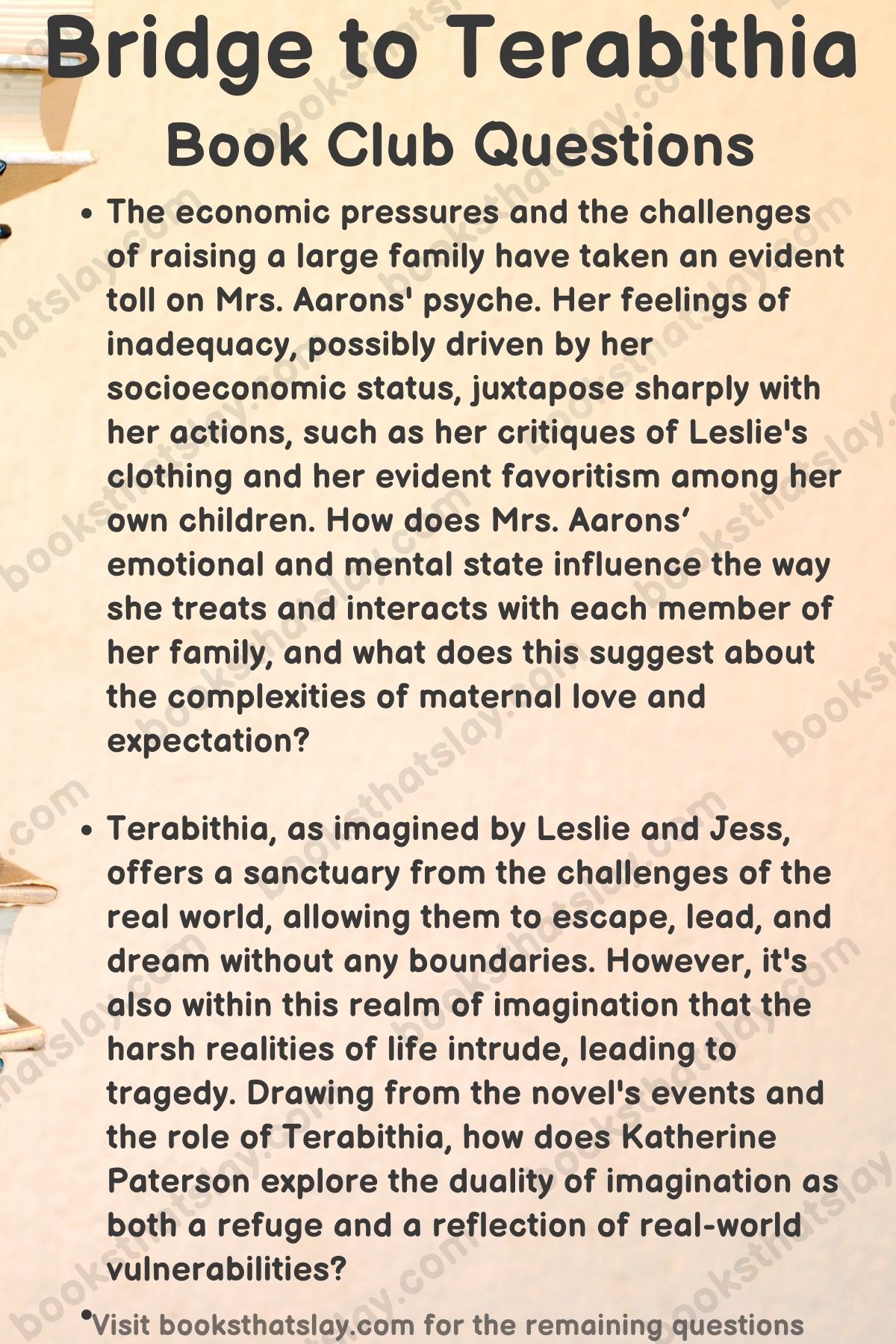10 Bridge to Terabithia Book Club Questions For Discussion
When we read a powerful novel like Katherine Paterson’s “Bridge to Terabithia,” we are not just observers in a tale of friendship, loss, and growth; we are active participants in the intellectual journey it offers.
Set against the backdrop of a rural community, this timeless story traverses the challenging terrains of family dynamics, societal norms, and the emotional complexities of growing up. While the plot itself is compelling, it’s the multi-dimensional characters that add rich layers to the narrative, urging us to look beyond the surface and delve into the intricacies of their thoughts and actions.
To assist you in this journey of exploration, we’ve crafted a series of detailed discussion questions for Bridge to Terabithia that touch on key characters and themes in the novel.
These questions aim to challenge your perceptions, provoke thoughtful debate, and offer a deeper understanding of the complexities that each character embodies.
Let’s begin.

Bridge to Terabithia Book Club Questions
- Within the pages of the novel, Jess’s love for art is a significant part of his character. It’s an outlet for him, providing a solace he doesn’t find in his everyday life. However, societal pressures, especially from his father, have caused him to hide and suppress this passion, associating it with weakness or being “girly.”
How does this internal and external conflict surrounding Jess’s passion shape his character development and his interactions with those around him, especially in relation to his evolving friendship with Leslie? - The economic pressures and the challenges of raising a large family have taken an evident toll on Mrs. Aarons’ psyche. Her feelings of inadequacy, possibly driven by her socioeconomic status, juxtapose sharply with her actions, such as her critiques of Leslie’s clothing and her evident favoritism among her own children.
How does Mrs. Aarons’ emotional and mental state influence the way she treats and interacts with each member of her family, and what does this suggest about the complexities of maternal love and expectation? - The economic disparities between the families of Lark Creek, most notably between the Aarons and the Burkes, provide a backdrop to the narrative. The Burkes, having moved from a wealthy suburb to experience a simpler life, and the Aarons, who face daily struggles of poverty, have distinct experiences even within the same community.
In what ways does the novel explore the complexities and nuances of these socioeconomic differences, particularly through the eyes of Jess and Leslie, and how do these dynamics influence their relationship? - Initially perceived by the students as stern and unapproachable, Mrs. Myers reveals a more compassionate side following Leslie’s death. Her openness about her personal loss and her subsequent empathy towards Jess provides a window into her own struggles.
How does the evolution of Mrs. Myers’ character challenge our initial perceptions of her, and what does this transformation teach readers about the layers of humanity present in those we may hastily judge? - For Jess and Leslie, the magical kingdom of Terabithia stands as a realm of limitless imagination and freedom. It is a place where they can escape the confines and cruelties of their real-world surroundings.
Considering the roles that imagination and escape play in the story, how does Terabithia symbolize the sanctuary that children often seek from the pressures and challenges of their real lives, and what does this tell us about the universal themes of childhood? - Throughout the narrative, Brenda and Ellie Aarons consistently behave in self-centered ways, showcasing their manipulation and indifference towards the struggles of those around them. Their reactions to the family’s financial hardships and Leslie’s tragic death further emphasize their lack of empathy and maturity.
Given the consistency in their character portrayals, what message might Katherine Paterson be trying to convey about the dangers of stagnation in personal growth? - When Leslie attends church with Jess on Easter, she is introduced to the story of Jesus’ resurrection. The novel navigates the complex waters of belief and spirituality, especially when Jess and May Belle warn Leslie about the implications of not believing in Jesus.
What insights does Leslie’s response to the concept of faith, and her reluctance to accept a vengeful God, provide on the broader themes of belief, acceptance, and individual perspectives in the narrative? - The tragic death of Leslie profoundly shakes Jess, leading him through a harrowing journey of grief, guilt, and eventual acceptance. Leslie’s impact on Jess doesn’t end with her death, however, as the creation of a bridge to Terabithia and the crowning of May Belle as its new queen attest.
How does Jess’s decision to keep Terabithia alive, even after Leslie’s passing, underscore the novel’s message about the enduring power of memories, the resilience of the human spirit, and the importance of passing on legacies? - In a community bound by conventional norms and expectations, Leslie Burke stands out not just due to her socioeconomic status, but more strikingly, because of her indomitable spirit, unique interests, and refusal to conform. From her choice of clothes to her relationships with adults and peers alike, Leslie challenges traditional notions at every turn.
Given her prominent role in Jess’s life and the larger community, what does Leslie’s character say about the power and potential consequences of challenging societal norms and championing individuality? - Terabithia, as imagined by Leslie and Jess, offers a sanctuary from the challenges of the real world, allowing them to escape, lead, and dream without any boundaries. However, it’s also within this realm of imagination that the harsh realities of life intrude, leading to tragedy.
Drawing from the novel’s events and the role of Terabithia, how does Katherine Paterson explore the duality of imagination as both a refuge and a reflection of real-world vulnerabilities?
Read our other posts